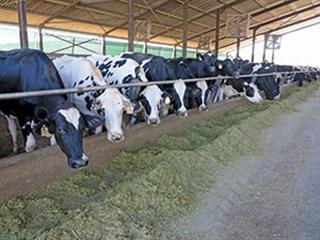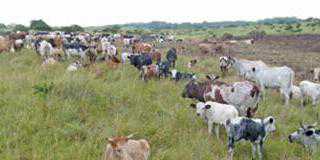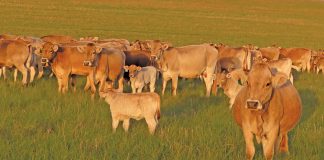
On his 1 000ha farm Swartwater outside Darling, 12km from the Atlantic Ocean on the West Coast, JK Basson milks his registered Holstein herd, Ocean Breeze Holsteins. He has been dairy farming since 1990, growing the herd his father JK Senior established in 1963.
He runs it like a well-oiled machine with 750 cows on a three-times-a-day milking regime. “I milk Holsteins because of their volumes,” he says. “The North Americans took this breed and developed it specifically for milk production and that’s what I need,” explains JK.
The sea breeze coming in off the Atlantic at Swartwater keeps temperatures down and animals cool and makes Darling’s climate suited to dairy farming. “Even so, our cows are housed indoors with fans to cool them down when the temperature rises above 22°C. Higher temperatures lead to heat stress, which causes appetite loss and a consequent drop in milk production.”
Feeding
JK feeds his milkers a total mixed ration (TMR) designed by animal nutritionists. “It’s expensive,” he admits, “but it ensures maximum production. Cows are fed in the free stalls between milking.” He also grows oats for silage, straw and hay, and buys in distillers’ grain, lucerne and citrus pulp, which he adds to the ration.
Production
Production averages from 42l/day to 45l/day, depending on the season. “Heifers calve down at 24 months and generally remain in production for 2,3 lactations or until they are five. Once a cow averages below 27l/ day she is not profitable and is culled. That is my cut-off point.”
JK used to milk twice a day but noticed that cows suffered from udder stress in the morning. Now the Ocean Breeze herd is milked at 4.30am, 1pm and 7.30pm each day in a 48-point rotary parlour. Each milking takes about two hours.
“In 1996 when we started milking three times a day there was an immediate increase in yield from an average of 32l/ day/ cow to 36l/day/cow.”
Herd health
Inoculation protocols for the Ocean Breeze herd are computer-generated and animals are automatically selected out for treatment. Bedding in the housing is kept clean by weekly additions of fresh sand mixed with lime to kill micro-organisms. Once a day during milking, bedding is sprayed with Envirocide.
The herd’s mastitis level is maintained at between 0,5 and 1%. JK says that as long as the somatic cell count (SCC) stays low, mastitis is not a problem. His SCC is currently
160 000 and never rises above 210 000.
He says that SCCs of above 300 000 lead to decreased production and more cases of sub-clinical and clinical mastitis. The herd is tested annually for TB and CA and receives a clearance certificate. “My milk buyer, Darling Roomery, insists on this certification,” he says.
The ultimate dairy cow
The best milk-producing cow is not necessarily the largest cow, explains JK. “I want a medium to large frame cow with a good spring of ribs and the capacity for high intakes. A wide, well-attached udder and good feet and legs are also important.”
He rarely experiences calving difficulties as he chooses bulls carefully. “I inseminate my cows and use high calving ease bulls on heifers. Genetics is critical and I select bulls best qualified to maintain good milk production.” JK uses World Wide Sires mating programme (WWS) for bull selection.
Electronic efficiency
The Afikim electronic system used by JK is an advanced herd management tool that scans the animals on a constant basis. Pedometers fitted to the animals’ back legs track and measure movement. Heifers are brought into the dairy daily to have their pedometers read.
“When a cow goes dry, we remove the pedometer and 21 days before she calves we replace it. Cows walk over a scale that records their weight and pedometer readings show activity levels. High activity is an indicator that a cow is cycling,” he explains.
Every cow in the herd is ear-tagged. At the top of the tag is the dam’s number, in the middle is the sire’s name, and below is the cow’s number. “When a cow steps onto the turntable, her pedometer is read and linked to her ear tag. Individual cow data can then be automatically loaded onto the computer and the animal’s record updated.”
Information such as the time and duration of milking, total daily production, electrical conductivity of the milk (a high salt level may indicate susceptibility to mastitis), temperature, activity level and weight are recorded three times a day. JK can tell when an animal is cycling (usually every 21 days) as milk production drops when movement increases and intakes decrease. Loss of weight and milk can mean that the cow is sick.
Small changes can be picked up by the Afikim ‘eye’ which is always on the herd. JK says that Afikim helps the farmer by reducing his need to be physically present to check on his herd. “Identified animals are diagnosed and treated and the information is loaded onto their files.”
Price-takers
According to JK, a dairyman has to be a productive perfectionist with a good system in place to stay viable. “Yes, I complain about the milk price. These are tough times and we don’t get what we feel we should. Feed, our single biggest cost, has gone up dramatically.”
Home-grown silage reduces the feed cost but JK’s feed bill is still very high. “In the past, the milk price seemed better because the feed price was lower and demand was greater. Now the supermarkets want cheap milk, which makes it difficult for a dairy producer to survive.”
As price-takers, dairy farmers must accept the price they are given. Prices will only improve in a local or national milk shortage. “Western Cape farmers really battle to get a better price in the supermarkets. If I compare our prices with those in Gauteng, there’s a big difference,” says JK.
Challenges
“The Western Cape is the most difficult and expensive dairy producing region in South Africa,” he explains. “With winter rain we can’t plant maize and there is not enough water for irrigation. We don’t have the grazing which the Eastern Cape and KwaZulu-Natal have. We can make silage but the protein content is lower than that of maize silage. So we buy in lucerne from north of Kimberley and live with the expensive transport costs.
“To make it in the Western Cape, dairy farmers have to grow. To be viable, a dairy needs to milk at least 600 cows. “I am as big as I can get for the size of my farm now and don’t have the option of further herd expansion. So I export some registered bulls and sell others to local dairy farmers. Next, I plan to start selling pregnant heifers.”
JK smiles but is serious when he says: “If anybody asks my advice whether or not to start dairy farming, I will say: ‘Don’t, you must be mad’. It is far more difficult to start out now than it was a few years ago, because everything is so expensive. Rotary parlours are very expensive and so is housing, which is essential in the Western Cape. During the cold wet winters, cows get mastitis and lose energy when walking in mud.
The future
“The government must support farmers by stopping dairy imports,” says JK. “We can’t compete with cheap imports. It seems the government simply doesn’t care for local farmers. Public education is also necessary for people to understand the importance of milk in the diet.” JK jokingly says that he only drinks milkshakes. “If I drank my milk, I would be eating my profits.”
JK Basson won National Dairy Farmer of the Year in 2008, and Western Cape Dairy Farmer of the Year in 2007 and 2008.













